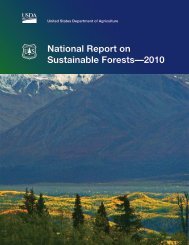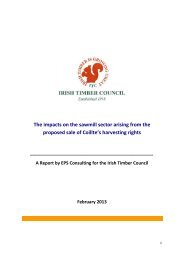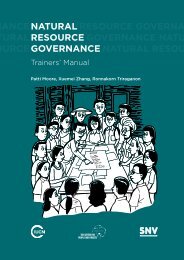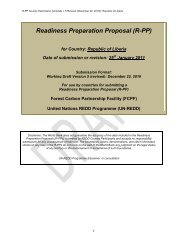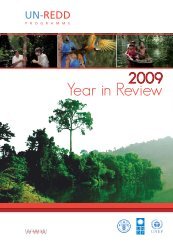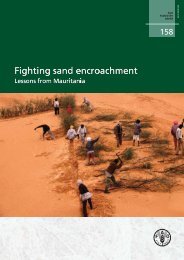pdf 1242 KByte - JIKO
pdf 1242 KByte - JIKO
pdf 1242 KByte - JIKO
You also want an ePaper? Increase the reach of your titles
YUMPU automatically turns print PDFs into web optimized ePapers that Google loves.
Policy Paper: Assessing prerequisites for market-based REDD+ activities 16<br />
3.2.4 Overseeing Safeguards and Establishing National Standards<br />
While the term safeguards is generally being associated with the objective of preventing and mitigating social<br />
and/or environmental damage, in the context of REDD+ the concept also includes the aim of promoting<br />
benefits (Moss / Nussbaum 2011). This definition is linked to the broadening of the mechanism’s scope,<br />
which has been expanded from REDD to REDD+. By including the “conservation, sustainable management<br />
of forests and enhancement of forest carbon stocks in developing countries” the original assumptions of unconditional<br />
benefits on biodiversity and other ecosystem services which where originally considered as cobenefits<br />
became obsolete. Therefore, the term co-benefits has been replaced by safeguards now including<br />
both, avoiding negative impacts as well as enhancing positive effects (Pistorius et al. 2011).<br />
In order to achieve these goals when implementing REDD+ on the ground, national governments in REDD+<br />
countries will have to establish national standards as well as social and environmental safeguards in line with<br />
international requirements. This is particularly important if countries are to develop a system with direct<br />
payments to carbon right holders (Vatn / Angelsen 2009).<br />
Requirements at UNFCCC level<br />
Concerns about potential adverse effects of REDD+ activities led civil society organisations as well as indigenous<br />
peoples and forest dependent communities groups to actively promote the establishing of REDD+<br />
safeguards at the international level. At the Cancún conference, Parties agreed on a list of safeguards<br />
(UNFCCC 2011, Appendix 1, para 2). When developing their national strategies and action plans, countries<br />
are inter alia requested to ensure that indigenous peoples’ and local communities’ rights are being respected<br />
and their full and effective participation is guaranteed. Furthermore, Parties agreed that REDD+ activities<br />
have to be consistent with the conservation of natural forests and biological diversity, and countries are to<br />
ensure that activities are not used for the conversion of natural forests but serve to enhance social and environmental<br />
benefits (UNFCCC 2011, Appendix 1, para 2). In addition, Parties in Cancun requested REDD+<br />
countries to develop a “system for providing information on how the safeguards […] are being addressed and<br />
respected throughout the implementation of the [REDD+] activities…” (UNFCCC 2011, para 71 (d)). 4 In<br />
Durban, it was decided that guidance on how REDD+ countries should establish Safeguard Information Systems<br />
(SIS) is to be developed.<br />
Implications for REDD+ countries<br />
Different implications follow from these safeguard requirements, one central element being the involvement<br />
of stakeholders potentially affected by the REDD+ activities and ensuring their rights are being respected.<br />
Public participation can be of great importance to inform governments on the needs and values associated<br />
with forests and improve the design of REDD+ activities. Furthermore, active participation could help in<br />
creating ownership among stakeholders and could thus increase accountability, legitimacy and credibility of<br />
public authorities (Morgera 2009). However, explicit guidelines on how countries should give communities<br />
the possibility to actively participate in REDD+ decision making are still lacking. Since the Cancun agreements<br />
make indirect reference to the United Nations Declaration on the Rights of the Indigenous Peoples<br />
(UNDRIP), the concept of Free, Prior and Informed Consent (FPIC), which has been adopted by UNDRIP,<br />
seems best suited for ensuring the “full and effective participation” of affected communities. This concept<br />
4 Other safeguards included in the Decision are ensuring permanence and avoiding leakage of emission reductions. These aspects have already been<br />
adressed in section 3.1 and will therefore not be considered in this section.<br />
Nicolas Kreibich, Christof Arens and Wolfgang Sterk<br />
Wuppertal Institute




